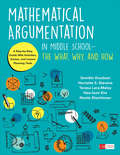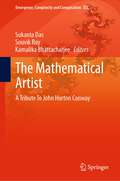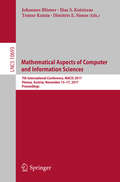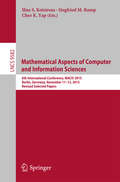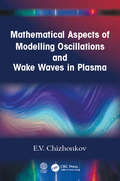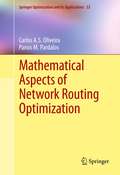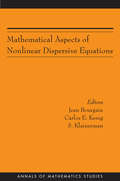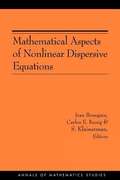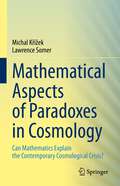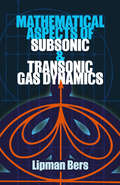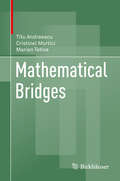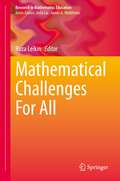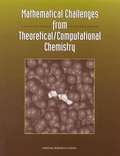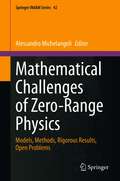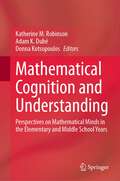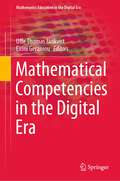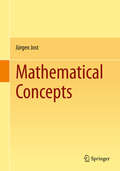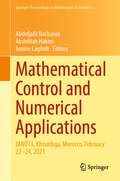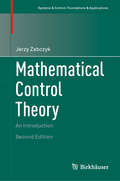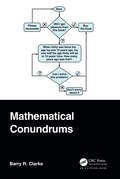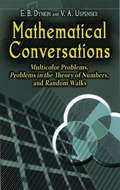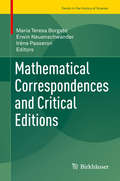- Table View
- List View
Mathematical Argumentation in Middle School-The What, Why, and How: A Step-by-Step Guide With Activities, Games, and Lesson Planning Tools (Corwin Mathematics Series)
by Jennifer Knudsen Harriette Stevens Teresa Lara-Meloy Hee-Joon Kim Nikki ShechtmanGet them talking: Your formula for bringing math concepts to life! Want your middle schoolers to intelligently engage with mathematical ideas? Look no further. This research-based gem brings tough Standards for Mathematical Practice 3 standards for mathematical argumentation and critical reasoning alive—all within a thoroughly explained four-part model that covers generating cases, conjecturing, justifying, and concluding. Immediately engage students in fun, classroom-ready argumentation activities Help students explore—and take ownership of—mathematical ideas and concepts Promote precise use of mathematical language Includes games, vignettes, a rich companion website, sample tasks, and links to online tools. Bring well-planned, well-constructed mathematical discourse to life in your classroom today!
The Mathematical Artist: A Tribute To John Horton Conway (Emergence, Complexity and Computation #45)
by Sukanta Das Souvik Roy Kamalika BhattacharjeeThis book brings together the impact of Prof. John Horton Conway, the playful and legendary mathematician's wide range of contributions in science which includes research areas—Game of Life in cellular automata, theory of finite groups, knot theory, number theory, combinatorial game theory, and coding theory. It contains transcripts where some eminent scientists have shared their first-hand experience of interacting with Conway, as well as some invited research articles from the experts focusing on Game of Life, cellular automata, and the diverse research directions that started with Conway's Game of Life. The book paints a portrait of Conway's research life and philosophical direction in mathematics and is of interest to whoever wants to explore his contribution to the history and philosophy of mathematics and computer science. It is designed as a small tribute to Prof. Conway whom we lost on April 11, 2020.
Mathematical Aspects of Computer and Information Sciences
by Johannes Blömer Ilias S. Kotsireas Temur Kutsia Dimitris E. SimosThis book constitutes the refereed proceedings of the 7th International Conference on Mathematical Aspects of Computer and Information Sciences, MACIS 2017, held in Vienna, Austria, in November 2017. The 28 revised papers and 8 short papers presented were carefully reviewed and selected from 67 submissions. The papers are organized in the following topical sections: foundation of algorithms in mathematics, engineering and scientific computation; combinatorics and codes in computer science; data modeling and analysis; and mathematical aspects of information security and cryptography.
Mathematical Aspects of Computer and Information Sciences
by Ilias S. Kotsireas Siegfried M. Rump Chee K. YapThis book constitutes the thoroughly refereedpost-conference proceedings of the 6th International Conference on MathematicalAspects of Computer and Information Sciences, MACIS 2015, held in Berlin,Germany, in November 2015. The 48 revised papers presented together with 7 invitedpapers were carefully reviewed and selected from numerous submissions. Thepapers are grouped in topical sections on curves and surfaces, appliedalgebraic geometry, cryptography, verified numerical computation, polynomialsystem solving, managing massive data, computational theory of differential anddifference equations, data and knowledge exploration, algorithm engineering ingeometric computing, real complexity: theory and practice, global optimization,and general session.
Mathematical Aspects of Fluid Mechanics
by James C. Robinson José L. Rodrigo Witold SadowskiThe rigorous mathematical theory of the equations of fluid dynamics has been a focus of intense activity in recent years. This volume is the product of a workshop held at the University of Warwick to consolidate, survey and further advance the subject. The Navier–Stokes equations feature prominently: the reader will find new results concerning feedback stabilisation, stretching and folding, and decay in norm of solutions to these fundamental equations of fluid motion. Other topics covered include new models for turbulent energy cascade, existence and uniqueness results for complex fluids and certain interesting solutions of the SQG equation. The result is an accessible collection of survey articles and more traditional research papers that will serve both as a helpful overview for graduate students new to the area and as a useful resource for more established researchers.
Mathematical Aspects of Modelling Oscillations and Wake Waves in Plasma
by E. V. ChizhonkovThis book is devoted to research in the actual field of mathematical modeling in modern problems of plasma physics associated with vibrations and wake waves excited by a short high-power laser pulse. The author explores the hydrodynamic model of the wake wave in detail and from different points of view, within the framework of its regular propagation, a development suitable for accelerating electrons, and the final tipping effect resulting in unregulated energy transfer to plasma particles. Key selling features: Presents research directly related to the propagation of super-power short laser pulses (subject of the 2018 Nobel Prize in Physics). Presents mathematical modeling of plasma physics associated with vibrations and wake waves excited by a short high-power laser pulse. Includes studies of large-amplitude plasma oscillations. Most of the presented results are of original nature and have not appeared in the domestic and foreign scientific literature Written at a level accessible for researchers, academia, and engineers.
Mathematical Aspects of Network Routing Optimization
by Carlos A.S. Oliveira Panos M. PardalosBefore the appearance of broadband links and wireless systems, networks have been used to connect people in new ways. Now, the modern world is connected through large-scale, computational networked systems such as the Internet. Because of the ever-advancing technology of networking, efficient algorithms have become increasingly necessary to solve some of the problems developing in this area. "Mathematical Aspects of Network Routing Optimization" focuses on computational issues arising from the process of optimizing network routes, such as quality of the resulting links and their reliability. Algorithms are a cornerstone for the understanding of the protocols underlying multicast routing. The main objective in the text is to derive efficient algorithms, with or without guarantee of approximation. Notes have been provided for basic topics such as graph theory and linear programming to assist those who are not fully acquainted with the mathematical topics presented throughout the book. "Mathematical Aspects of Network Routing Optimization" provides a thorough introduction to the subject of algorithms for network routing, and focuses especially on multicast and wireless ad hoc systems. This book is designed for graduate students, researchers, and professionals interested in understanding the algorithmic and mathematical ideas behind routing in computer networks. It is suitable for advanced undergraduate students, graduate students, and researchers in the area of network algorithms.
Mathematical Aspects of Nonlinear Dispersive Equations (Annals of Mathematics Studies #163)
by Jean Bourgain; Carlos E. Kenig & S. KlainermanThis collection of new and original papers on mathematical aspects of nonlinear dispersive equations includes both expository and technical papers that reflect a number of recent advances in the field. The expository papers describe the state of the art and research directions. The technical papers concentrate on a specific problem and the related analysis and are addressed to active researchers. The book deals with many topics that have been the focus of intensive research and, in several cases, significant progress in recent years, including hyperbolic conservation laws, Schrödinger operators, nonlinear Schrödinger and wave equations, and the Euler and Navier-Stokes equations.
Mathematical Aspects of Nonlinear Dispersive Equations
by S. Klainerman Jean Bourgain Carlos E. KenigThis collection of new and original papers on mathematical aspects of nonlinear dispersive equations includes both expository and technical papers that reflect a number of recent advances in the field. The expository papers describe the state of the art and research directions. The technical papers concentrate on a specific problem and the related analysis and are addressed to active researchers. The book deals with many topics that have been the focus of intensive research and, in several cases, significant progress in recent years, including hyperbolic conservation laws, Schrödinger operators, nonlinear Schrödinger and wave equations, and the Euler and Navier-Stokes equations.
Mathematical Aspects of Paradoxes in Cosmology: Can Mathematics Explain the Contemporary Cosmological Crisis?
by Michal Křížek Lawrence SomerThis book provides a mathematical and numerical analysis of many problems which lead to paradoxes in contemporary cosmology, in particular, the existence of dark matter and dark energy. It is shown that these hypothetical quantities arise from excessive extrapolations of simple mathematical models to the whole physical universe. Written in a completely different style to most books on General Relativity and cosmology, the important results take the form of mathematical theorems with precise assumptions and statements. All theorems are followed by a corresponding proof, or an exact reference to the proof.Some nonstandard topics are also covered, including violation of the causality principle in Newtonian mechanics, a critical mathematical and numerical analysis of Mercury's perihelion shift, inapplicability of Einstein's equations to the classical two-body problem due to computational complexity, non-uniqueness of the notion of universe, the topology of the universe, various descriptions of a hypersphere, regular tessellations of hyperbolic spaces, local Hubble expansion of the universe, neglected gravitational redshift in the detection of gravitational waves, and the possible distribution of mass inside a black hole. The book also dispels some myths appearing in the theory of relativity and in contemporary cosmology. For example, although the hidden assumption that Einstein's equations provide a good description of the evolution of the whole universe is considered to be obvious, it is just a null hypothesis which has not been verified by any experiment, and has only been postulated by excessive extrapolations of many orders of magnitude.
Mathematical Aspects of Subsonic and Transonic Gas Dynamics
by Lipman BersThis concise volume by a prominent mathematician offers an important survey of mathematical aspects of the theory of compressible fluids. The treatment is geared toward advanced undergraduates and graduate students in physics, applied mathematics, and engineering. Focusing on two-dimensional steady potential flows, the text eschews detailed proofs in favor of clear indications of the main ideas and descriptions of new mathematical concepts and methods that arose in connection with these chapters in fluid dynamics.Starting with a general discussion of the differential equations of a compressible gas flow, the book advances to the mathematical background of subsonic flow theory. Subsequent chapters explore the behavior of a flow at infinity and methods for the determination of flows around profiles, flows in channels and with a free boundary, the mathematical background of transonic gas dynamics, and some problems in transonic flow. An extensive bibliography of 400 papers concludes the text.
Mathematical Bridges
by Titu Andreescu Cristinel Mortici Marian TetivaBuilding bridges between classical results and contemporary nonstandard problems, this highly relevant work embraces important topics in analysis and algebra from a problem-solving perspective. The book is structured to assist the reader in formulating and proving conjectures, as well as devising solutions to important mathematical problems by making connections between various concepts and ideas from different areas of mathematics. Instructors and motivated mathematics students from high school juniors to college seniors will find the work a useful resource in calculus, linear and abstract algebra, analysis and differential equations. Students with an interest in mathematics competitions must have this book in their personal libraries.
Mathematical Challenges For All (Research in Mathematics Education)
by Roza LeikinThis book argues that mathematical challenge can be found at any level and at every age and constitutes an essential characteristic of any mathematics classroom aimed at developing the students’ mathematical knowledge and skills. Since each mathematics classroom is heterogeneous with respect to students’ mathematical potential, quality mathematical instruction results from matching the level of mathematical challenge to different students’ potential. Thus, effective integration of mathematical challenge in the instructional process is strongly connected to the equity principle of mathematics education. In the three sections in this volume readers can find diverse views on mathematical challenges in curriculum and instructional design, kinds and variation of mathematically challenging tasks and collections of mathematical problems. Evidence-based analysis is interwoven with theoretical positions expressed by the authors of the chapters. Cognitive, social and affective characteristics of challenging mathematical activities are observed and analyzed. The volume opens new avenues of research in mathematics education, and pose multiple questions about mathematical instruction rich in mathematical challenge for all. The authors invite readers to explore and enjoy mathematical challenges at different levels.
Mathematical Challenges from Theoretical/Computational Chemistry
by Committee on Mathematical Challenges from Computational ChemistryComputational methods are rapidly becoming major tools of theoretical, pharmaceutical, materials, and biological chemists. Accordingly, the mathematical models and numerical analysis that underlie these methods have an increasingly important and direct role to play in the progress of many areas of chemistry. This book explores the research interface between computational chemistry and the mathematical sciences. In language that is aimed at non-specialists, it documents some prominent examples of past successful cross-fertilizations between the fields and explores the mathematical research opportunities in a broad cross-section of chemical research frontiers. It also discusses cultural differences between the two fields and makes recommendations for overcoming those differences and generally promoting this interdisciplinary work.
Mathematical Challenges of Zero-Range Physics: Models, Methods, Rigorous Results, Open Problems (Springer INdAM Series #42)
by Alessandro MichelangeliSince long over the decades there has been a large transversal community of mathematicians grappling with the sophisticated challenges of the rigorous modelling and the spectral and scattering analysis of quantum systems of particles subject to an interaction so much localised to be considered with zero range. Such a community is experiencing fruitful and inspiring exchanges with experimental and theoretical physicists. This volume reflects such spirit, with a diverse range of original contributions by experts, presenting an up-to-date collection of most relevant results and challenging open problems. It has been conceived with the deliberate two-fold purpose of serving as an updated reference for recent results, mathematical tools, and the vast related literature on the one hand, and as a bridge towards several key open problems that will surely form the forthcoming research agenda in this field.
Mathematical Cognition and Understanding: Perspectives on Mathematical Minds in the Elementary and Middle School Years
by Katherine M. Robinson Adam K. Dubé Donna KotsopoulosThis book focuses on elementary and middle school children’s understanding of mathematics as well as the cognitive aspects involved in the development of mathematical knowledge, skills, and understanding. Children’s success in and understanding of mathematics stem from factors beyond the mathematics curriculum. Researchers are increasingly becoming aware of the necessity to consider a complex set of variables when accounting for large individual differences in mathematics achievement. These chapters contribute to how both researchers and educators can consider the multidimensionality of skills involved in developing mathematical knowledge in the middle school years as well as to how this knowledge can be used to enhance practices in the mathematics classroom. Topics include the cognitive and spatial skills involved in mathematics knowledge, the role of motivation in mathematics learning, the neurological processes and development of children’s mathematics skills, the development of understanding of arithmetic and fraction concepts, the factors relating to children’s word problem success, and techniques to promote mathematics understanding. This book and its companion, Mathematical Teaching and Learning, take an interdisciplinary perspective to mathematical learning and development in the elementary and middle school years. The authors and perspectives in this book draw from education, neuroscience, developmental psychology, and cognitive psychology. The book will be relevant to scholars/educators in the field of mathematics education and also those in childhood development and cognition. Each chapter also includes practical tips and implications for parents as well as for educators and researchers.
Mathematical Competencies in the Digital Era (Mathematics Education in the Digital Era #20)
by Uffe Thomas Jankvist Eirini GeraniouThis book focuses on the potential interplay between two distinct, yet related paradigm shifts in mathematics education, drawing on the notion of “networking of theories” through illustrative case studies from the Danish educational system and beyond. The first paradigm shift is the massive introduction of digital technology in the teaching and learning of the subject; the second is a shift from the traditional focusing on mastering of skills and knowledge to being concerned with the possession and development of mathematical competencies. This book builds on the Danish KOM (Competencies and the Learning of Mathematics) project, which sources its description of mathematical mastery primarily on the notion of a “mathematical competency” rather than on lists of topics, concepts, and results. This allows for an overarching framework, which captures the perspectives of mathematics teaching and learning at whichever educational level. While the KOM framework does not in detail address the role of digital technologies in relation to its description of different types of mathematical competencies, etc., the chapters of this book set out to do exactly this, while in the process also drawing on a selection of other theoretical constructs and frameworks from mathematics education research. Starting with introductory chapters by key researchers in the area, the book brings forth chapters for each of the KOM framework’s eight mathematical competencies, authored by Nordic researchers in combination with international scholars. The KOM framework also operates with three types of overview and judgement, which are specifically addressed in relation to the role of digital technologies in the third part of the book. The fourth and final part of the book broadens the scene and provides chapters of a more perspective nature in relation to mathematical competencies in the digital era. The book’s preface is by Susanne Prediger.
Mathematical Concepts
by Jürgen JostThe main intention of this book is to describe and develop the conceptual, structural and abstract thinking of mathematics. Specific mathematical structures are used to illustrate the conceptual approach; providing a deeper insight into mutual relationships and abstract common features. These ideas are carefully motivated, explained and illustrated by examples so that many of the more technical proofs can be omitted. The book can therefore be used: · simply as an overview of the panorama of mathematical structures and the relations between them, to be supplemented by more detailed texts whenever you want to acquire a working knowledge of some structure · by itself as a first introduction to abstract mathematics · together with existing textbooks, to put their results into a more general perspective · to gain a new and hopefully deeper perspective after having studied such textbooks Mathematical Concepts has a broader scope and is less detailed than standard mathematical textbooks so that the reader can readily grasp the essential concepts and ideas for individual needs. It will be suitable for advanced mathematicians, postgraduate students and for scientists from other fields with some background in formal reasoning.
Mathematical Connections: A Bridge to Algebra and Geometry
by Francis J. Gardella Patricia R. Fraze Joanne E. Meldon Marvin S. WeingardenMathematical Connections is a bridge that will take you from where you are in your study of mathematics to algebra and geometry. Since topics in mathematics are connected, this course will also lead you to data analysis and probability.
Mathematical Constants II (Encyclopedia of Mathematics and its Applications #169)
by Steven R. FinchFamous mathematical constants include the ratio of circular circumference to diameter, π = 3.14 …, and the natural logarithm base, e = 2.718 …. Students and professionals can often name a few others, but there are many more buried in the literature and awaiting discovery. How do such constants arise, and why are they important? Here the author renews the search he began in his book Mathematical Constants, adding another 133 essays that broaden the landscape. Topics include the minimality of soap film surfaces, prime numbers, elliptic curves and modular forms, Poisson–Voronoi tessellations, random triangles, Brownian motion, uncertainty inequalities, Prandtl–Blasius flow (from fluid dynamics), Lyapunov exponents, knots and tangles, continued fractions, Galton–Watson trees, electrical capacitance (from potential theory), Zermelo's navigation problem, and the optimal control of a pendulum. Unsolved problems appear virtually everywhere as well. This volume continues an outstanding scholarly attempt to bring together all significant mathematical constants in one place.
Mathematical Control and Numerical Applications: JANO13, Khouribga, Morocco, February 22–24, 2021 (Springer Proceedings in Mathematics & Statistics #372)
by Abdeljalil Nachaoui Abdelilah Hakim Amine LaghribThis book presents some sufficient mathematical content with expressive result. The aim of JANO13 is to bring together scientists to discuss their research in all the aspects of mathematics and their applications to different scientific discipline. The main topics of the conference is partial differential equations, mathematical control, numerical analysis and computer science. The conference is interested in recent developments on numerical analysis and real applications in computer science. The latter is viewed as a dynamic branch on the interface of mathematics and informatics that has been growing rapidly over the past several decades. However, its mathematical modelling and interpretation are still not well-explained and need much more clarifications. The main contributions of this book are to give some sufficient mathematical content with expressive results. As a growing field, it is gaining a lot of attention both in media and in the industry world, which will attract the interest of readers from different scientist disciplines.
Mathematical Control Theory: An Introduction (Systems & Control: Foundations & Applications)
by Jerzy ZabczykThis textbook presents, in a mathematically precise manner, a unified introduction to deterministic control theory. With the exception of a few more advanced concepts required for the final part of the book, the presentation requires only a knowledge of basic facts from linear algebra, differential equations, and calculus.In addition to classical concepts and ideas, the author covers the stabilization of nonlinear systems using topological methods, realization theory for nonlinear systems, impulsive control and positive systems, the control of rigid bodies, the stabilization of infinite dimensional systems, and the solution of minimum energy problems.This second edition includes new chapters that introduce a variety of topics, such as controllability with vanishing energy, boundary control systems, and delayed systems. With additional proofs, theorems, results, and a substantially larger index, this new edition will be an invaluable resource for students and researchers of control theory.Mathematical Control Theory: An Introduction will be ideal for a beginning graduate course in mathematical control theory, or for self-study by professionals needing a complete picture of the mathematical theory that underlies the applications of control theory.From reviews of the first edition:At last! We did need an introductory textbook on control which can be read, understood, and enjoyed by anyone. Gian-Carlo Rota, The Bulletin of Mathematics BooksIt covers a remarkable number of topics...The exposition is excellent, and the book is a joy to read. A novel one-semester course covering both linear and nonlinear systems could be given...The book is an excellent one for introducing a mathematician to control theory. Bulletin of the AMSIndeed, for mathematicians who look for the basic ideas or a general picture about the main branches of control theory, I believe this book can provide an excellent bridge to this area. IEEE Control Systems Magazine
Mathematical Conundrums (AK Peters/CRC Recreational Mathematics Series)
by Barry R. ClarkeWant to sharpen your mathematical wits? If so, then Mathematical Conundrums is for you. Daily Telegraph enigmatologist, Barry R. Clarke, presents over 120 fiendish problems that will test both your ingenuity and persistence. Between these covers are puzzles in geometry, arithmetic, and algebra (there is even a section for computer programmers). And, for the smartest readers who wish to stretch their mind to its limits, a selection of engaging logic and visual lateral puzzles is included. Although no puzzle requires a greater knowledge of mathematics than the high school curriculum, this collection will take you to the edge. But are you equal to the challenge? Features High-school level of mathematics is the only pre-requisite Variety of algebraic, route-drawing, and geometrical conundrums Hints section for the lateral puzzles Warm-up excercises to sharpen the wits Full solutions to every problem Barry R. Clarke has published over 1,500 puzzles in The Daily Telegraph and has contributed enigmas to New Scientist, The Sunday Times, Reader’s Digest, The Sunday Telegraph, and Prospect magazine. His book Challenging Logic Puzzles Mensa has sold over 100,000 copies. As well as a PhD in Shakespeare Studies, Barry has a master’s degree and academic publications in quantum physics. He is now working on a revised theory of the hydrogen atom. Other skills include mathematics tutor, filmmaker, comedy-sketch writer, cartoonist, computer programmer, and blues guitarist! For more information please visit http://barryispuzzled.com.
Mathematical Conversations: Multicolor Problems, Problems in the Theory of Numbers, and Random Walks
by V. A. Uspenskii E. B. DynkinCombining three books into a single volume, this text comprises Multicolor Problems, dealing with several of the classical map-coloring problems; Problems in the Theory of Numbers, an elementary introduction to algebraic number theory; and Random Walks, addressing basic problems in probability theory.The book's primary aim is not so much to impart new information as to teach an active, creative attitude toward mathematics. The sole prerequisites are high-school algebra and (for Multicolor Problems) a familiarity with the methods of mathematical induction. The book is designed for the reader's active participation. The problems are carefully integrated into the text and should be solved in order. Although they are basic, they are by no means elementary. Some sequences of problems are geared toward the mastery of a new method, rather than a definitive result, and others are practice exercises, designed to introduce new concepts. Complete solutions appear at the end.
Mathematical Correspondences and Critical Editions (Trends in the History of Science)
by Maria Teresa Borgato Erwin Neuenschwander Irène PasseronMathematical correspondence offers a rich heritage for the history of mathematics and science, as well as cultural history and other areas. It naturally covers a vast range of topics, and not only of a scientific nature; it includes letters between mathematicians, but also between mathematicians and politicians, publishers, and men or women of culture. Wallis, Leibniz, the Bernoullis, D'Alembert, Condorcet, Lagrange, Gauss, Hermite, Betti, Cremona, Poincaré and van der Waerden are undoubtedly authors of great interest and their letters are valuable documents, but the correspondence of less well-known authors, too, can often make an equally important contribution to our understanding of developments in the history of science. Mathematical correspondences also play an important role in the editions of collected works, contributing to the reconstruction of scientific biographies, as well as the genesis of scientific ideas, and in the correct dating and interpretation of scientific writings. This volume is based on the symposium “Mathematical Correspondences and Critical Editions,” held at the 6th International Conference of the ESHS in Lisbon, Portugal in 2014. In the context of the more than fifteen major and minor editions of mathematical correspondences and collected works presented in detail, the volume discusses issues such as • History and prospects of past and ongoing edition projects, • Critical aspects of past editions, • The complementary role of printed and digital editions, • Integral and partial editions of correspondence, • Reproduction techniques for manuscripts, images and formulae, and the editorial challenges and opportunities presented by digital technology.
